My post for the #BowTieBoys guest host stint at #G2Great in March seemed easy. I reread the questions, reviewed the tweets, considered formats and began writing. In fact it was so easy that I began worrying about this second post. What would be different or unique? What would be the bookends for the learning?
I am in awe of these middle school and high school students: their focus, drive, poise and incredibly articulate positions on so many issues in education. As I worried about appropriately expressing my respect for their work, I remembered that April is synonymous with poetry. So I created this acrostic “fan poem” about the #BowTieBoys before we even had the chat and had my first 19 words.
After the chat, I was still in search of my goal for this blog post – stuck with my 19 words and the title. I dreamed of a post worthy of clearly and succinctly articulating the depth of their participation as guest hosts for #G2Great on April 26, 2018. But I felt like the center fielder who had missed a line drive straight up the middle.
So I researched, reading previous Literacy Lenses posts as well as posts from the #BowTieBoys. I even DM’d Jason Augustowski about a post outlining the origin of this group. You can find those details in his biography here. I read through the Wakelet artifact, collected tweets and reread the archive again. Ideas swirled in my head. And then I reread the title: Exploring Instruction through Students’ Eyes: Group Work and Collaboration and the theme coalesced around that title. No surprise. The title became my North Star, my purpose.
This group of students, ranging from 8th graders to juniors, wrote the questions, responded to the questions, and had multiple conversations with educational folks during the #G2Great twitter chat. In essence, they collaborated with each other in the question development and then participated collaboratively in group work during the chat. They executed group work and collaboration in an online format while sitting together in the same physical space. Middle school and high school students!
Were the students doing this for participation points?
Were the students doing this for a class requirement?
Was there a rubric where the teacher was making tally marks for participating comments?
Would a student be “marked down” for “not speaking up”?
The answer to each of those questions is a resounding “NO!” And therein lies the purpose. These students are learners who understand that they learn in different ways, like to respond in different ways, have different interests, but yet they are united in their passion to provide input in order to improve their educational lives. They read professional texts by Penny Kittle, Kelly Gallagher, Laura Robb, Linda Rief, etc. and strive to improve their own knowledge on their own time and in their own ways. (Does that sound familiar, dear readers, who have found your own personalized learning on Twitter, Voxer, or in books by similar authors?)
Student perspectives on learning are necessary in order to improve educational practices AND learning. Teachers need student feedback, beyond assessment numbers, that range from classroom environment to routines/procedures to the content and instructional delivery systems.
WHY?
Dr. Mary Howard is fond of telling us that our “WHY?” is our most important question to answer for any instruction, assessment or even planning. And she is so correct. Beyond teachers and administrators knowing the WHY, so must the students. The WHY cannot be left for students to infer. It should be obvious. It should be stated often. And it should be the driving force behind every decision made in the classroom, of the classroom and for the classroom.
Why Group Work?
These tweets really helped me collect a wide range of thoughts about Group Work.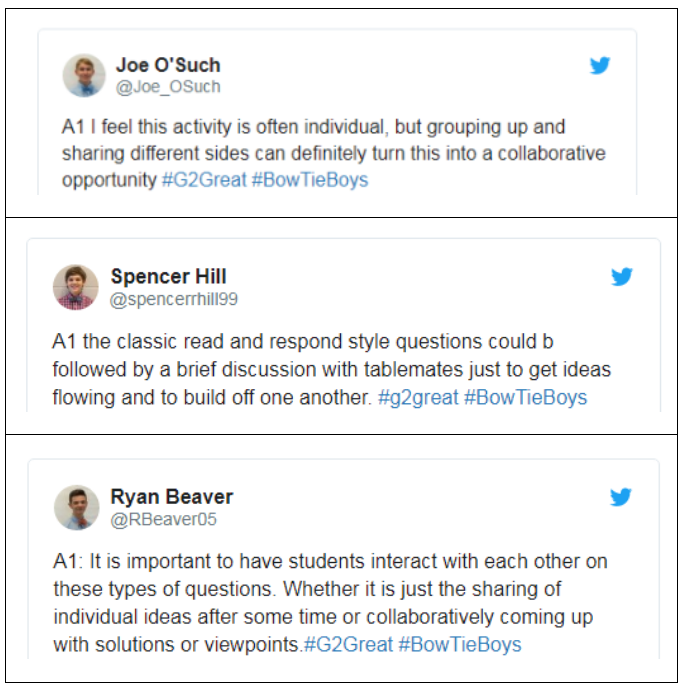
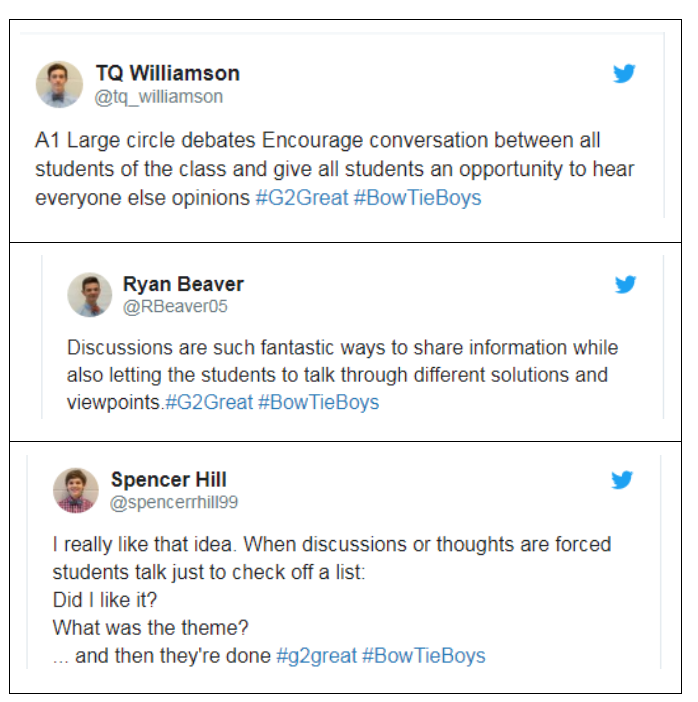
Why these tweets? Because of the key words that popped out in this word cloud.
Several priorities for Group Work had surfaced: Allowing all students to have a voice, providing opportunities to add ideas, affording time to discuss and/or gather information, new viewpoints and ideas, and encouraging others to interact. Aren’t those all habits and behaviors that employers want? Why would we ever be surprised that students want these? The surprise might be that students have not previously felt comfortable with sharing these needs. The surprise might be that some teachers don’t collect feedback from students. The surprise might be that the feedback is perfunctory and never acted upon.
But WHY NOT?
Why not have a combination of interactions daily in the classroom that allow students to learn together? Why not provide choice in interactions? Why not ask the students (voice) when learning is working as well as when it is not working?
WHY Collaboration?
For this second big topic, I again returned to the tweets for the benefits of collaboration.
Merriam Webster defines collaborate as “to work jointly with others or together especially in an intellectual endeavor” so it does overlap with the previous Group Work conversation. The heart of collaboration is that new thinking or product emerges as a result of collaboration. As you can see in the tweets, the students recognize that combinations of individual and group work are needed and that there needs to be a real purpose, not “just” a principal or teacher evaluation for the collaboration. The process of collaboration should include frequent checkpoints so that both the students and the teacher have frequent feedback on the effectiveness of the collaboration. Student ratings or rubrics designed collaboratively with the teacher and negotiated with group members are often effective. Will all groups be 100% effective every day? Probably not without some specially designed instruction, tasks and productive work that builds respect, trust and a community of learners commited to deep learning.
But WHY NOT?
As shared in the tweets, collaboration is not necessary for all tasks. Students recognize fake collaboration to impress an observer or to mark it off a checklist. And perhaps the beginning of a class period is not the best time for collaboration if students have not yet settled into the learning mode. Are there some tasks that are better suited to individual work? Having real world, meaningful tasks tends to make collaboration more successful.
WHY does it matter?
The goal is mutual learning. Students collaboratively involved in the learning processes have a deeper understanding of teaching just as teachers involved in collaborative work have a deeper understnding of student learning. When this commitment to education and learning is reciprocal, magic happens. That magic was evident in our #G2Great chat with the #BowTieBoys. Students. Teachers. Learners ALL. Understanding WHY is the essential element.
ACTION To Consider: Take these remarkable questions and discuss them with your teachers and classmates.
And summarize with:
WHY is Group Work important?
Is all Group Work equal?
WHY is Collaboration important?
How do Group Work and Collaboration support student learning? Find your WHY and find your guiding principles for learning!
Please follow the #BowTieBoys on Twitter:
Kellen Pluntke @kellenpluntke
Spencer Hill @spencerrhill99
Joe O’Such @joe_osuch
Christian Sporre @CSporre
Ryan Beaver @rbeaver05
Connor Grady @ConnorGrady11
TQ Williamson @tq_williamson
Rishi Singh @RishiSingh08
Sam Fremin @thesammer88
Dawson Unger @dawsonunger
Jack Michael @jackmichael776
Tam Mandanis @TMandanis
Aaron Eichenlaub @AEichenlaub729
Nihar Kandarpa @NKandarps
Jason Augustowski @misteramistera
Additional Resources:
| Storify from April 26, 2018 chat | Wakelet Link |
| Storify from March 8, 2018 chat | Storify Link |
| #BowTieBoys Blogs | thebowtieboys.blogspot.com |
| 4 minute video from 3/9/18 after #G2Great chat | Link |
| #BowTieBoys YouTube Channel | Link |
| #BowTieBoys Biographies | Link |
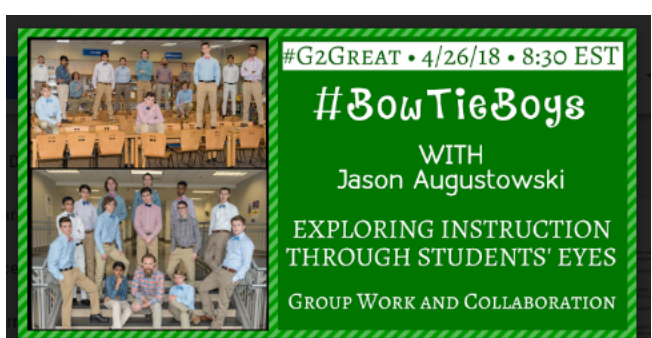

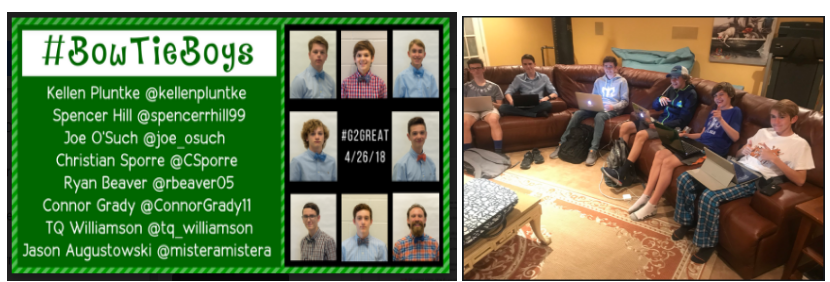
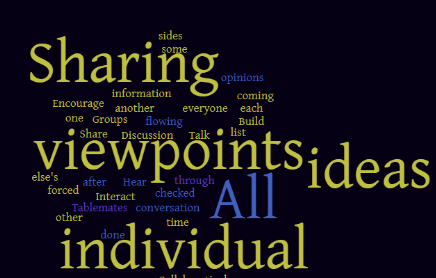
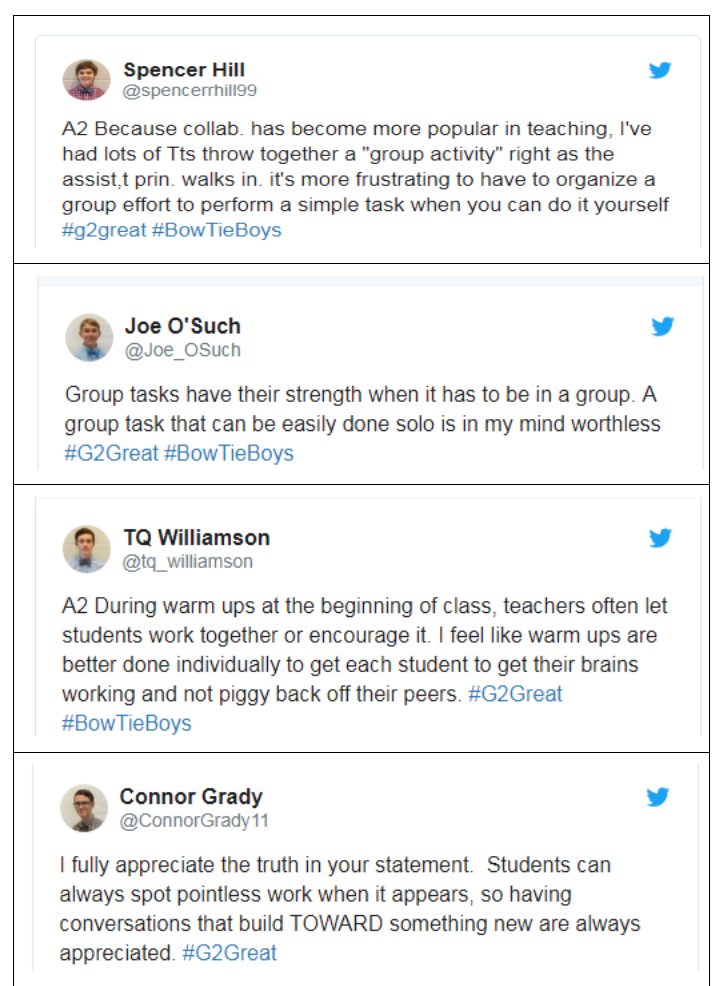
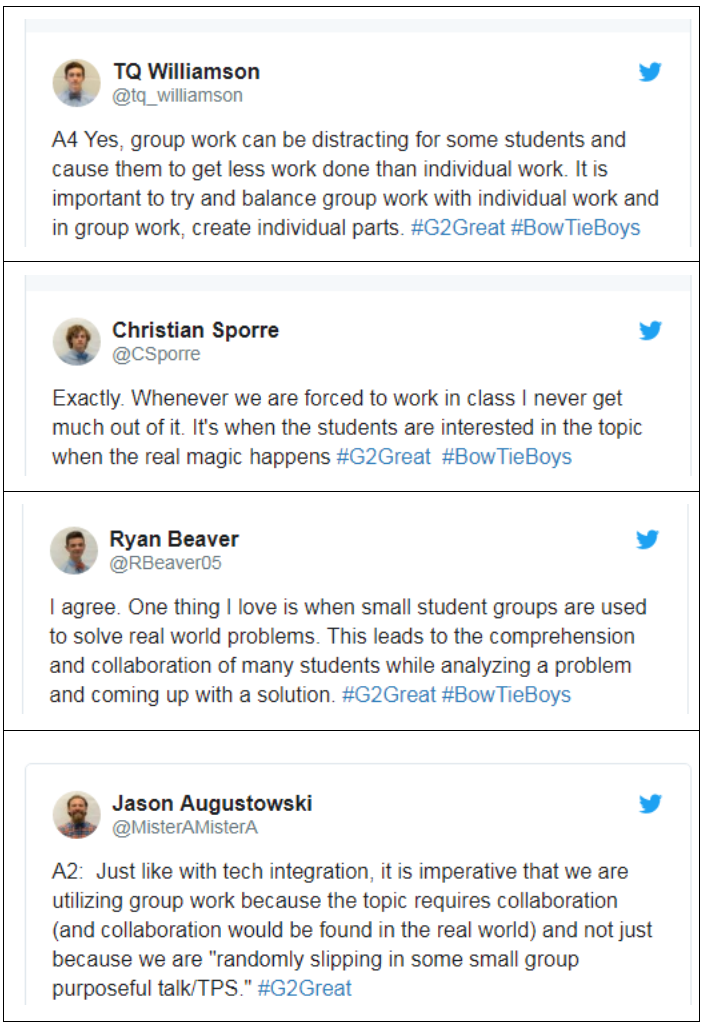

YouTube video of #BowTieBoys during the #G2Great chat – https://youtu.be/t85BkFZFQi8
Your incredible post is a testament to the impact these remarkable young men are having in the educational world Fran. You illustrated so eloquently how #BowTieBoys are able to bring us together and lift us up in meaningful conversations. It is astounding how they can not only pose just right questions but then engage in those questions to share both their own thinking and then interact so richly with others. You words are just a reminder why looking at our teaching through #BowTieBoys eyes could take our professional discourse to a whole new level.
Thanks, Mary!
Can you imagine the learning that would occur in classrooms if students and teachers honestly discussed their responses to the questions above? There wouldn’t be consensus on everything (nor would it be expected), but the genuine respect, trust and caring from being “heard” as well as the improved learning would definitely open new lines of communication. Sharing the WHYs in classrooms should become the new norm!